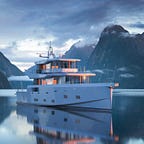Sustainable use of aluminium at sea
Why Aluminium? — Sustainability at Sea
Designing and building explorer yachts with minimal environmental costs
We started the Arksen project with a vision of designing and building explorer yachts that could go pretty much anywhere and with the hope that they would unlock in those who used them a deeper sense of adventure; a desire to explore and to learn.
We aimed to create vessels that would be in their element in the wilderness of the open ocean, edging through the ice in Glacier Bay or sitting in a tropical harbour.
Why Aluminium?
Fundamentally our choice of build materials is based on a necessity that we and our users must be able to rely on our products in the harshest of conditions, time and time again. Every component and element of the build is designed with this in mind.
Choosing materials that we trust, understand and love to work with is all part of our DNA.
Making any product has an environmental impact, and an Arksen vessel is a big ‘product’. Our first responsibility is to ensure that the materials that we use in building our boats have as minimal an environmental cost as possible, both during production and use, and that they are fully recyclable at the end of life. As importantly, we wanted to be able to trace the materials that we worked with and to be able to track their provenance through a trusted supply chain.
To develop the hull and superstructure concept, we looked at a lot of different materials commonly used in boat building; GPR, composite, wood, steel and even concrete but only aluminium had all of the properties that we were looking for.
Aluminium is a unique metal: strong, durable, flexible, impermeable, lightweight, corrosion-resistant, non-toxic, 100% recyclable and 100% sustainable.
You can weld it, bash it, and cast it. It can be shaped and twisted into any form. It can be rolled into thick plates for hulls, thin foil for wires (and drinks cans) and extruded for tubes. It reflects about 80% of the light that strikes it and almost nine-tenths of the heat that reaches it, which is why astronauts’ space suits have an aluminium coating which prevents extreme heat loss as well as gain. Using the same principle, it can help keep a room warm or cool. Marine grade aluminium alloys are also, pound for pound, stronger than structural steel.
Aluminium is everywhere — literally. It is the most abundant, naturally occurring metal in the earth’s crust but it also has a high scrap value as a recyclable metal. Its reusable cycle is indefinite, and it retains all of its qualities, which is why nearly 75% of all aluminium ever produced globally is still in use today and recycling accounts for over one-half of total aluminium production.
Some metals wear away if exposed to oxygen, water, weather or various chemicals. However, when aluminium reacts with oxygen the metal forms an invisible layer of a chemical compound called aluminium oxide. This layer protects the aluminium from corrosion, making it especially valuable for use outdoors where the metal is exposed to and must resist the effects of wind, rain, water and pollution.
Of all the many valuable properties of aluminium, the most important for the thru life costs of an Arksen vessel is that aluminium is one of the lightest metals. It weighs about 168.5 pounds per cubic foot, about a third as much as steel. It’s low density, combined with its high strength, rigidity and corrosion resistance allows weight savings of 15 to 20 percent over steel or many composite designs, which in turn means less friction, less power requirement and less fuel.
The Department of Energy’s Oak Ridge National Laboratory found that an aluminium intensive vehicle can achieve up to a 32% reduction in total life cycle energy consumption.
The production of aluminium is expensive because it requires a lot of expensive energy to refine. But once aluminium has been refined and used, it can be melted down and recycled using one-twentieth of the energy it took to make it in the first place. By saving this amount of energy, not only can resources like coal and oil be saved, but less acid rain gases such as sulphur and nitrogen oxides are released in the atmosphere.
The combination of these properties makes aluminium an ideal material to build the Arksen range:
- Very lightweight, strong and safe: Lighter and stronger than steel or GRP, a well-designed aluminium hull will reduce the costs of ownership through fuel efficiency. If you are unlucky enough to collide with an object at sea an aluminium hull is significantly less likely to puncture.
- Low maintenance: Aluminium is self-protecting, which means less paint, fewer materials, less maintenance, less cost.
- Reusable/recyclable: Aluminium is infinitely recyclable and retains a very high scrap value.
- Excellent marine construction material: Aluminium is safe to work with, highly reliable, predictable when welded and malleable making it the material of choice for specialist boat builders.
- Long service life: A well-maintained aluminium hull will last many years — our vessels are designed with a 50-year service life in mind.
- Ease of repair: Our intrepid users will be able to find someone who can work with it anywhere in the world.
Sustainability underpins everything we do at Arksen. Discover our full set of philosophies here.
Originally published at https://www.arksen.com.
